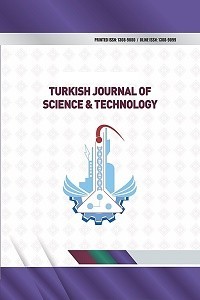Determination of Mechanical Properties of the Concrete Affected by High Temperature by Destructive and Non-Destructive Test Methods
Determination of Mechanical Properties of the Concrete Affected by High Temperature by Destructive and Non-Destructive Test Methods
high temperature, adherence strength, pull-out, ultrasonic pulse velocity,
___
- REFERENCES
- [1] Luccioni, B. M., Figueroa, M. I., Danesi, R. F., Thermo-mechanic model for concrete exposed to elevated temperatures, Engineering Structure, 2003; 25:729–42. [2] Sanad, A. M., Lamont, S., Usmani, A. S., Rotter, J. M., Structural behaviourin fire compartment under different heating regimes—Part 1 (slab thermal gradients), Fire Safety Journal , 2000; 35:99–116.[3] Hertz, K. D., Concrete strength for fire safety design, Magazine of Concrete Research, 2005; 57(8):445–53.[4] Kalifa, P ., Menneteau, D. F., Quenard, D., Cement Concrete Research, 30:1915–27, 2000.[5] Ichikawa, Y., England, G. L., Prediction of moisture migration and pore pressure build-up in concrete at high temperatures, Nuclear Engineering Desing, 2004; 228:245–59.[6] Akman, M. S., Yapı Hasarları ve Onarım İlkeleri, İstanbul: TMMOB İnsaat Mühendisleri Odası, 2000.[7] Shoaib, M. M., Ahmed, S. A., and Balaha, M. M., Effect of Fire and Cooling Mode on the Properties of Slag Mortars, Cement and Concrete Research, 2001; 31:1533-1538.[8] Perkins, P. H., Repair, Protection and Waterproofing of Concrete Structures, Elseveir Applied Science, 1986; England.[9] Riley, M. A., Possible New Method for the Assessment of Fire Damaged Concrete, Magazine of Concrete Research, 1991; 43:(155), 87-92.[10] Hammer, T. A., , Compressive Strength and E Modulus of Elevated Temperatures, Report 6.1, High Strength Phase 3.SINTEF-repport nr STF70 A 95023, 1995; Trondheim, 16.[11] Aydın, S., Baradan, B., Yüksek Sıcaklıga Dayanıklı Gelistirilmesi, TMMOB Insaat Mühendisleri Odası 5. Ulusal Beton Kongresi, 2003; 451-460.[12] Baradan, B., Yazıcı, H., and Ün, H., Betonarme Yapılarda Kalıcılık (Durabilite), İzmir: Dokuz Eylül Üniversitesi Mühendislik Fakültesi Yayınları, Yayın No 298, 2002.[13] Khoury, G. A., Fire & Assessment, International Centre for Mechanical Sciences, Course on Effect of Heat on Concrete, 2003; Udine/Italy.[14] Scherefler, B. A., Brunello, P., Gawin, D., Majorana, C. E. and F. Pesavento, Concrete at High Temperature with Application to Tunnel Fire, Computational Mechanics, 2002; 29: 223-234. [15] Kristensen, L., and Hansen, T. C., Cracks in concrete core due to fire on thermal heating shock, ACI Materials Journal, 1994; 91 (5):453-459.[16] Phan, L. T., and Carino, N. J., Review of Mechanical Properties of HSC at Elevated Temperatures, Journal of Materials in Civil Engineering, 1998; 10:58- 64.[17] Chan, Y. N., Peng, G. F., and Anson, M., Residual strength and pore structure of high-strength concrete and normal strength concrete after exposure to high temperatures, Cement and Conrete Composites, 1999; 21:23-27.[18] Luo, X., Chan, S. Y. N., and Sun, W., Effect of high temperature and cooling regimes on the compressive strength and pore properties of high performance concrete, Construction and Building Materials, 2000;14: 261-¬266.[19] Poon, C. S., Azhar, S., Anson, M., and Wong, Y. L., Comparison of the strength and durability performance of normal and high sterngth pozzolanic concretes at eleveted temperatures, Cement and Concrete Research, 2001; 31: 1291-1300.[20] Jonatka, I., and Bagel, L., Pore structures permabilities and compressive strengths of concrete at temperatures up to 800 0C, ACI Materials Journal, 2002; 99 (2):196-200.[21] Demirel, B., and Gönen, T., Yüksek sıcaklığın karbon lif takviyeli hafif betonda basınç dayanımı ve poroziteye etkisi, Pamukkale Üniversitesi Mühendislik Fakültesi Mühendislik Bilimleri Dergisi, 2008; 14(2):223-228.[22] TS EN 1008, Mixing water for concrete – Specification for sampling, testing and assessing the suitability of water, including water recovered from processes in the concrete industry, as mixing water for concrete, Turkish Standard, Nisan, 2003.[23] TS EN 12350-5, Testing frehs concrete- Part 5: Flow table test, Turkish Standard, Nisan, 2001.[24] Baradan, B., Yazıcı, H., and Ün, H., Betonarme Yapılarda Kalıcılık (Durabilite), İzmir: Dokuz Eylül Üniversitesi Mühendislik Fakültesi Yayınları, 298, 2002.[25] TS EN 12390-3, Testing hardened concrete - Part 3: Compressive strength of test specimens, Nisan, 2003.[26] ASTM C597 – 09, Standard Test Method for Pulse Velocity Through Concrete, American Standard.
- ISSN: 1308-9080
- Başlangıç: 2009
- Yayıncı: Fırat Üniversitesi
Bahar DEMİREL, Salih YAZICIOĞLU, Rukiye TUĞLA, Serhat AY
Seasonal Variations of Zooplankton in Nazik Lake (Turkey)
Serap SALER, Hilal BULUT, Seçil GÜNEŞ, Kenan ALPASLAN, Gökhan KARAKAYA
Simulation and Optimization of A Crude Oil Distillation Unit
Fethi KAMIŞLI, Ari Abdulqader AHMED
